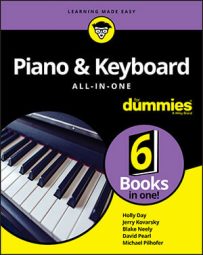So many composers, so little time. Both the famous and the not so famous have written enough piano exercises and études to fill your practice time, not to mention your bookshelf. The most difficult are challenging for any pianist, and many are useful to pianists at all levels. Not surprisingly, the greatest composers wrote some very difficult exercise pieces, but even if you don't get around to playing them, listening can be rewarding and instructive.
What follows is a selective list of some of the top collections by the top composers. If you have a local music store, thank your lucky stars and buy from that establishment. Or look for them online at websites like Amazon or Barnes and Noble.
Johannes Brahms (1833–1897): Johannes Brahms's Fifty-One Exercises are pure exercises, not at all performance pieces, yet they have the musicality, invention, and rigor that are the hallmarks of Brahms's writing. They're a real workout. (Published by G. Schirmer)
Frédéric Chopin (1810–1849): Chopin wrote two books of Études, opus 10 and opus 25 (24 pieces in all), that cover the full range of technical possibility. More to the point, it's all incredibly beautiful music. (Published by Henle)
Muzio Clementi (1752–1832): Gradus ad Parnassum (The Art of Playing the Pianoforte) is three volumes of piano exercises, totaling 100 pieces, in a variety of forms and styles, ranging from intermediate to advanced level. (Published by Kalmus)
Karl Czerny (1791–1857): Karl Czerny is the king of piano exercises. He studied with Beethoven and taught Liszt — not a bad résumé. He wrote for all levels, covering the scope of techniques used in his day. Try 40 Daily Exercises (published by G. Schirmer), and if you're hungry for more exercises you can surely find something just for you in volumes such as Studies for Small Hands, The Art of Finger Dexterity, School of Velocity, Eight-Measure Exercises, Study Pieces for the Beginner, 24 Studies for the Left Hand, 100 Recreations, and The School of Legato and Staccato.
Claude Debussy (1862–1918): Written near the end of Debussy's life, 12 Études are equally beautiful and intricate studies that have titles like "For Thirds," "For Repeated Notes," and "For Octaves," describing their technical focus. They're divided into two volumes. (Published by Durand)
Enrique Granados (1867–1916): Six Expressive Studies are intermediate-level estudios and are so expressive you won't stop to think about all the exercise you're getting. (Published by Masters Music Publications)
Franz Liszt (1811–1886): Before there were long-haired rock stars, there was Franz Liszt, virtuoso concert pianist and composer of passionate piano music that's quintessentially romantic. His Transcendental Études are transcendentally hard, but great to listen to. (Published by Edition Peters)
Edward MacDowell (1861–1908): Edward MacDowell's attractive character pieces in Twelve Studies are fun for practice or performance. He also wrote Twelve Virtuoso Studies, which is more challenging but also attractive. (Published by G. Schirmer)
Carl Nielsen (1865–1931): Piano Music for Young and Old has "24 short pieces in different keys" that do about as much as anyone would think possible with your hands in five-finger position. They're varied styles and tempos, not too long and not too hard, just right all around. (Published by Wilhelm Hansen)
Sergei Rachmaninoff (1873–1943): In the same league with those of Chopin and Liszt, Rachmaninoff's Études-Tableaux shows off a top-notch technique and is complex and highly expressive. (Published by Boosey & Hawkes)

